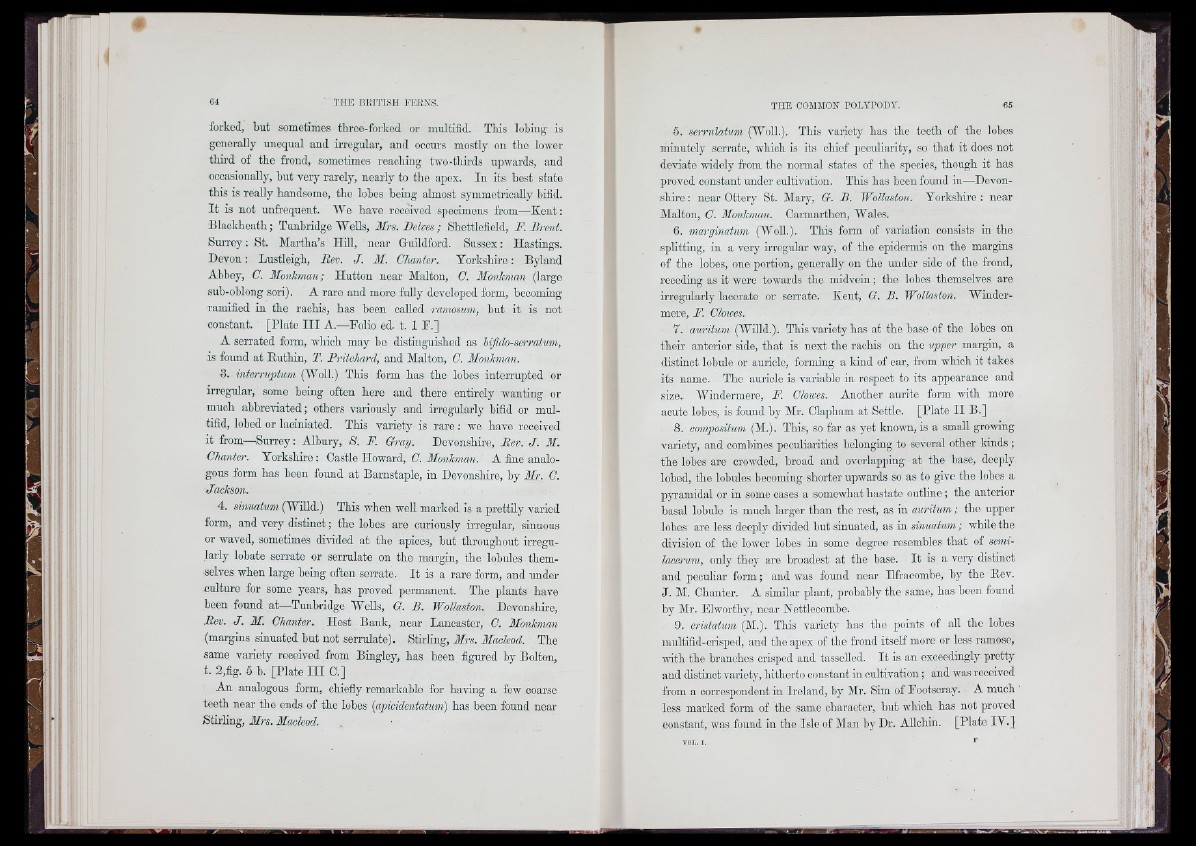
forked, but sometimes tlirec-forkod or multifld. This lobing is
generally unequal and irregular, and ooours mostly on the lowrer
third of the frond, sometimes reaching tivo-thirds upw'ards, and
occasionally, but very rarely, nearly to the apox. In its best state
this is really handsome, the lobes being almost symmetrically bifid.
I t is not unfrcquont. Wc have received specimens from—Kent;
Elackheath; Tunbridge Wells, Mrs. Dekes; Shettlofiold, F. Brent.
Surrey: St. Martha’s Hill, near Guildford. Sussex; Hastings.
Devon: Lustleigh, Rev. J . M. Chanter. Yorkshire: Byland
Abbey, C. Monhnan; Hutton near Maltón, C. Monkman (large
suh-oblong sori). A rare and more fully developed form, boooming
ramified in tho raohis, has boon called ramosimi, but it is not
constant. [Plate I I I A.—Folio ed. t. I F .]
A serrated form, which may bo distinguished as hifido-serratum,
is found at Euthin, T. Pritchard, and Maltón, C. Monkman.
3. interniptmn (Woll.) This form has the lobes interrupted or
irregular, some boing often here and tbcro entirely wanting or
much abbreviated; others variously and irregularly bifid or multifid,
lobed or laoiniated. This variety is rare : wc have received
it fi'om—Surrey: Albury, S. F. Gray. Devonshire, Rev. J . M.
Chanter. Yorkshire: Castle Howard, 0. Monkman. A fine analogous
form has been found at Barnstaple, in Devonshire, by Mr. C.
Jackson.
4. siniiatum (Willd.) This when well marked is a prettily varied
form, and very distinct; the lobes are curiously irregular, sinuous
or waved, sometimes divided at tho apices, hut throughout irregularly
lohate serrate or serrulate on the margin, tho lobules themselves
when large boing often serrate. I t is a rare form, and under
culture for some years, has proved permanent. The plants have
been found at—Tunbridge Wells, G. B. Wollaston. Devonshire,
Rev. J . M. Chanter. Hest Bank, near Lancaster, C. Monkman
(margins sinuated hut not serrulate). Stirling, Mrs. Maoleod. The
same variety received from Bingley, has been figured by Bolton,
t. 2,fig. 5 b. [Plate I I I C.]
An analogous form, chiefly remarkable for having a few coarse
teeth near the ends of tho lobes (apieidentatmn) bas boon found near
Stirling, Mrs. Macleod.
5. sernilatmn (Woll.). This variety has the teeth of the lobes
minutely serrate, which is its chief peculiarity, so that it does not
deviate widely from the normal states of tho species, though it has
proved constant under cultivation. This has been found in—Devonshire
: near Ottory St. Mary, G. B. Wollaston. Yorkshire ; near
Maltón, C. Monkman. Carmarthen, Wales.
6. marginatum (Woll.). This form of variation consists in the
splitting, in a very irregular -way, of the epidermis on the margins
of the lobes, one portion, generally on the under side of the frond,
recoding as it were towards the midvein; the lobes themselves aro
irregularly lacerate or serrate. Kent, G. B. Wollaston. Winder-
mere, F. Clou'cs.
7. auritum (Willd.). This variety has at tho base of the lobes on
their anterior side, that is next the rachis on the upper margin, a
distinct lobule or auricle, fonning a kind of oar, from which it takes
its name. Tho auricle is variable in respect to its appearance and
size. Windermere, F. Cloivcs. Another aurite form witb more
acute lobes, is found by Mr. Clapham at Settle. [Plate I I B.]
8. compositum (M.). This, so far as yet known, is a small growing
variety, and combines peculiarities belonging to several other kinds ;
tbe lobes are crowded, broad and overlapping at tbe base, deeply
lobed, tbe lobules boooming shorter upwards so as to give the lobes a
pp-amidal or in some oases a somewhat hastate outline ; the anterior
basal lobule is much larger than the rest, as in auritum; the upper
lobes are less deeply divided but sinuated, as in sinuatum,; while the
division of tho lower lobes in some degree resembles that of sem-i-
lacerimi, only they aro broadest at tho base. I t is a very distinct
and peculiar form; and was found near Ilfraoomhe, hy the Rev.
J. M. Chanter. A similar plant, probably tbe samo, bas been found
by Mr. El worthy, near Nettlooombo.
9. cristatum (M.). This variety has tho points of all the lobes
multifid-crispod, and tho apox of tho frond itself more or less ramose,
with the branches crisped and tasselled. I t is an oxcoodingly pretty
and distinct variety, hitherto constant iu cultivation; and was received
from a correspondent in Ireland, hy Mr. Sim of Footsoray. A much
less marked form of the same character, hut which has not proved
constant, was found in the Isle of Man by Dr. Allchin. [Plate IV.}
-ill 1
I i.
I
i i r
i:
li'if u
■■I'0 1
I ' l l l
i 'Á ‘I